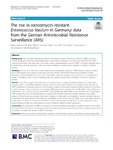The rise in vancomycin-resistant Enterococcus faecium in Germany: data from the German Antimicrobial Resistance Surveillance (ARS)
Markwart, Robby
Willrich, Niklas
Haller, Sebastian
Noll, Ines
Koppe, Uwe
Werner, Guido
Eckmanns, Tim
Reuss, Annicka
Background
Due to limited therapeutic options, vancomycin-resistant Enterococcus faecium (VREF) is of great clinical significance. Recently, rising proportions of vancomycin resistance in enterococcal infections have been reported worldwide. This study aims to describe current epidemiological trends of VREF in German hospitals and to identify factors that are associated with an increased likelihood of vancomycin resistance in clinical E. faecium isolates.
Methods
2012 to 2017 data from routine vancomycin susceptibility testing of 35,906 clinical E. faecium isolates from 148 hospitals were analysed using data from the German Antimicrobial Resistance Surveillance System. Descriptive statistical analyses and uni- and multivariable regression analyses were performed to investigate the impact of variables, such as year of sampling, age and region, on vancomycin resistance in clinical E. faecium isolates.
Results
From 2014 onwards the proportions of clinical E. faecium isolates exhibiting resistance to vancomycin increased from 11.2% (95% confidence interval [CI] 9.4–13.3%) to 26.1% (95% CI 23.1–29.4%) in 2017. The rise of VREF proportions is primarily observed in the southern regions of Germany, whereas northern regions do not show a major increase. In the Southwest and Southeast, VREF proportions increased from 10.8% (95% CI 6.9–16.5%) and 3.8% (95% CI 3.0–11.5%) in 2014 to 36.7% (95% CI 32.9–40.8%) and 36.8% (95% CI 29.2–44.7%) in 2017, respectively. VREF proportions were considerably higher in isolates from patients aged 40–59 years compared to younger patients. Further regression analyses show that in relation to secondary care hospitals, E. faecium samples collected in specialist care hospitals and prevention and rehabilitation care centres are more likely to be vancomycin-resistant (odds ratios: 2.4 [95% CI 1.2–4.6] and 2.4 [95% CI 1.9–3.0], respectively). No differences in VREF proportions were found between female and male patients as well as between different clinical specimens.
Conclusion
The proportion of VREF is increasing in German hospitals, particularly in southern regions in Germany. Increased efforts in infection control and antibiotic stewardship activities accounting for local resistance patterns are necessary to combat the spread of VREF in Germany.

